This article was originally published on 2Fast4Buds and appears here with permission.
Many consumers have seen a cannabis flower and maybe leaf but have never seen a plant grow from seed.
When growing cannabis, it’s essential you become familiar with the anatomy of a cannabis plant to know what they need and prevent problems.
It's crucial you know the parts of a cannabis plant such as roots, nodes, calyxes, and trichomes, and what they’re used for to be able to maintain a healthy garden.
1. ANATOMY OF FEMALE VS MALE PLANTS
Cannabis plants are dioecious, this means they have separate sexes, so the plants can be male or female.
In cannabis, the female plant produces high levels of cannabinoids and develops flowers (buds) while the male plant produces low levels and develops pollen sacs.
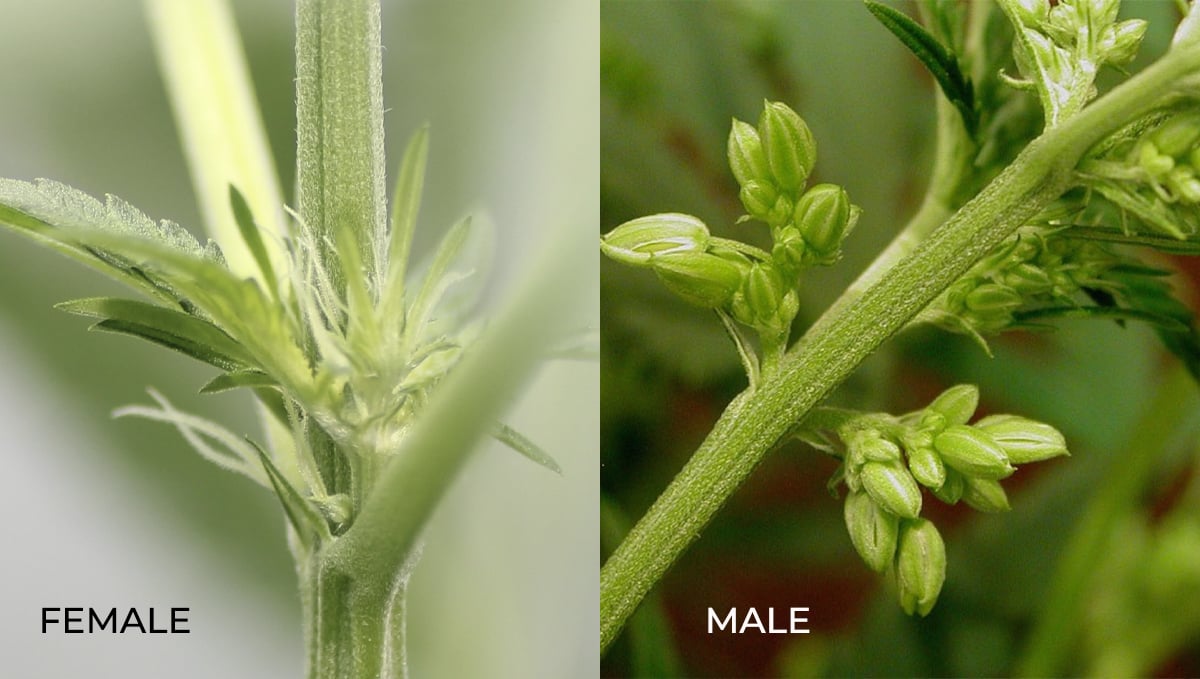
Female vs male cannabis flowers.
When both of them interact, the pollen fertilizes flowers, producing seeds which are used for breeding and cannabis cultivation.
It’s essential you know which one you need to grow to achieve the desired results, so in this article, we’ll explain the main differences and the anatomy of a cannabis plant.
2. SEEDS AND SEEDLINGS
A seed is the first thing you need to start growing your own cannabis, a cannabis seed has a hard shell to protect the embryo, this embryo is what will develop into a seedling when germinated.
When exposed to the right temperature and moisture, you will see a seedling (baby plant) start to develop, this seedling comes out of the medium with a small pair of green rounded leaves named cotyledons.
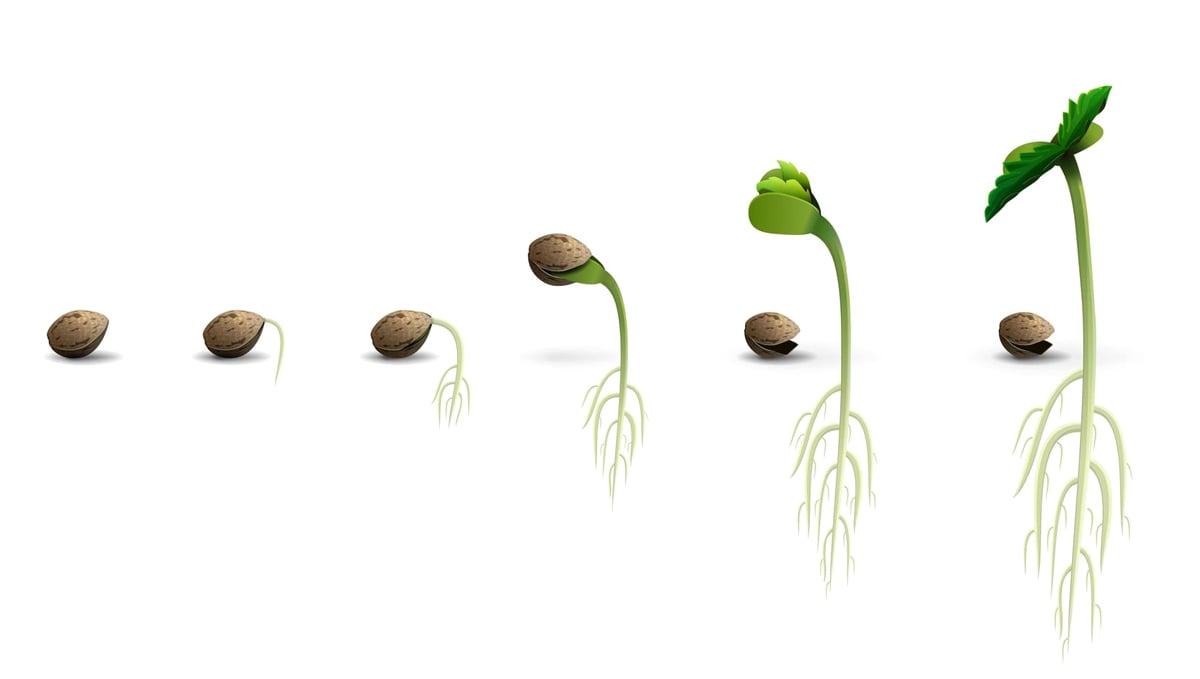
The first days of a cannabis plant life cycle.
The cotyledons already contain chlorophyll which allows the tiny leaves to perform photosynthesis but it’s only in the early vegetative stage that you will see the first pair of serrated leaves develop and this is when the plant will start to absorb energy and nutrients, and direct it to the growth of foliage and stems.
3. ROOTS
After 3-5 days of exposing the seed to germination conditions, you will see a white “tail” coming out of the seed, this “tail” will start to grow longer and thicker as soon as the seed is planted and will eventually become your plant’s taproot, which is the main root from where rootlets sprout.
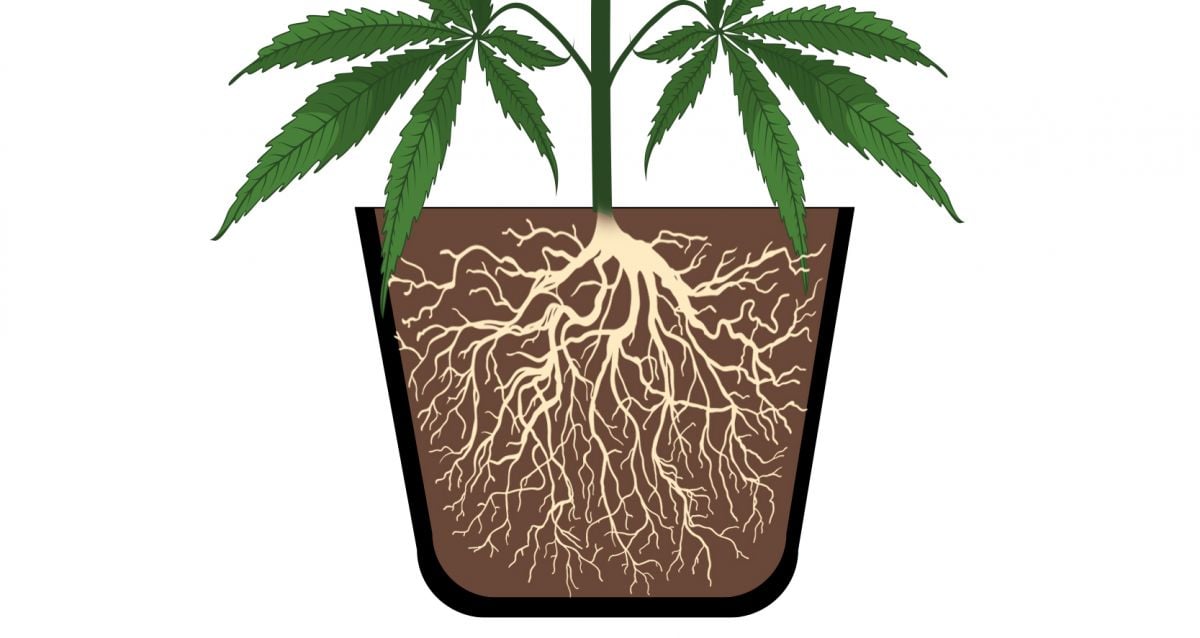
Plant root network properly established.
Once the taproot grows to a considerable size, several lateral roots will start to emerge from it, forming a network of roots in the soil, this root network is responsible for absorbing water and nutrients which are vital for your plant’s growth.
4. FAN LEAVES
After the cotyledons have appeared, they will be exposed to sunlight. This is important because the cotyledons use photosynthesis to absorb sunlight and produce energy for the plant to grow. After a couple of days, the first serrated leaves will appear, and as the plant grows, bigger foliage will appear and each time they will have more apexes, which are the fingers of a cannabis fan leaf.
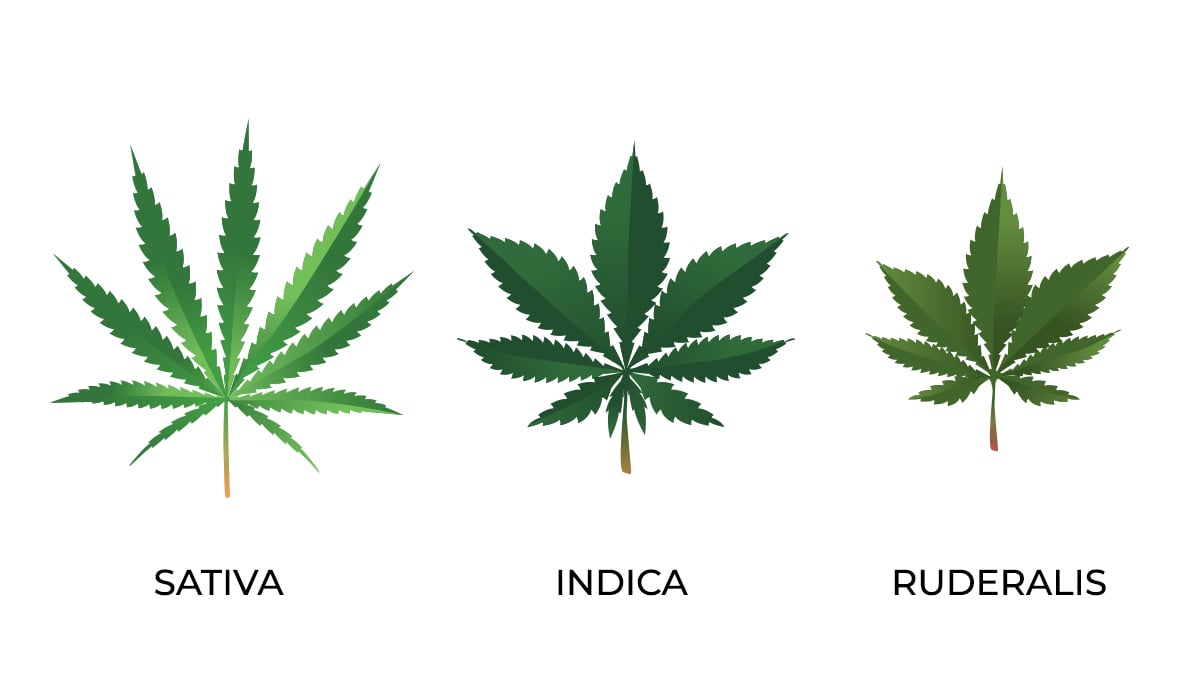
Difference in the leaves of cannabis species.
Depending on the genetics, the foliage can have five, seven, nine, or more fingers but either way, independent of the number of apexes, the fan leaves use sun, water, and C02 to produce sugars.
Also, the leaves are different depending on the genetics, for example, Indica leaves are usually wider with more fingers while Sativa leaves are thinners and have more fingers, there are also autoflowers that start with leaves similar to Ruderalis leaves and it can get complicated to differentiate so here’s a table to help you figure it out easier.
CANNABIS LEAF CHARACTERISTICS
| Species | Leaf characteristics |
|---|---|
| Sativa | Skinnier with up to 13 “fingers”. |
| Indica | Fat and wide leaves with up to 9 “fingers”. |
| Ruderalis | Short and compact, developing 3-5 “fingers. |
These sugars are a cannabis plant’s source of energy and it fuels growth and all the biological processes it needs.
Have in mind that even though the foliage is a part of a cannabis plant, they have low levels of cannabinoids so their purpose is to absorb sunlight, store water, and also protect the buds from sunburn but are not usually smoked.
5. SUGAR LEAVES
Sugar leaves are regular leaves but unlike fan leaves, they’re not too big and usually grow in between the buds. This foliage can sometimes have trichomes on them but will depend on the trichome production of each specific strain.
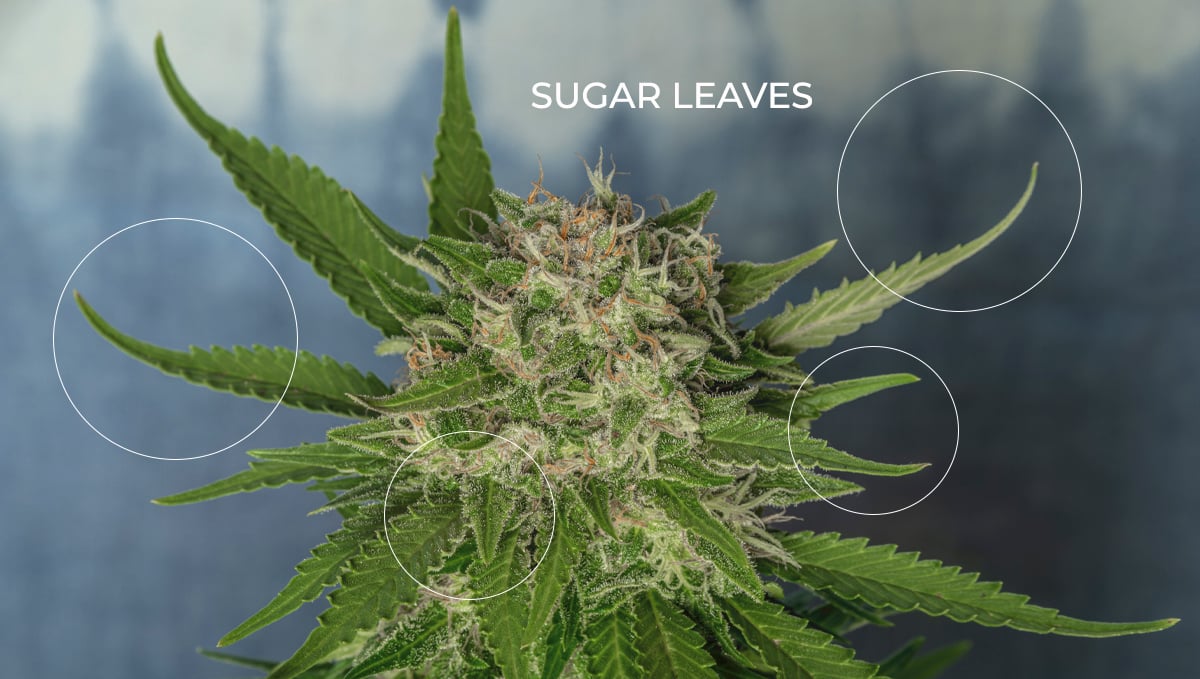
Sugar leaves are the resinous leaves that grow in between the buds.
These leaves contain less resin that buds and are usually not consumed but depending on the quality of the genetics, these leaves can be used to make edibles, oils, and extracts.
6. PRE-SEX STRUCTURES
The pre-sex structures appear on the internodes in the pre-flowering stage of the cannabis plant, if your plant turns out to be a male, you’ll see small balls appearing which are pollen sacs in the early stages.
These pollen sacs will eventually develop and open up, releasing the pollen needed to produce seeds, now, if you see white hairs (stigmas) instead of pollen sacs, your plant is definitely a female.
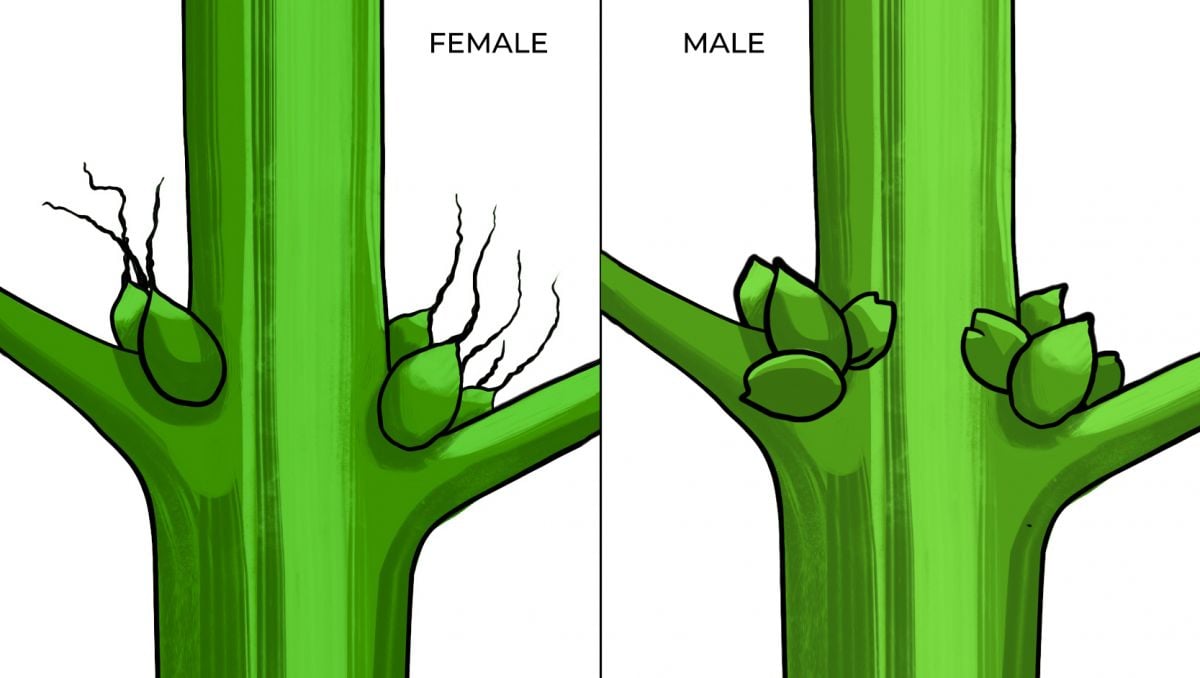
How to identify the sex of your cannabis plants.
If you’re a home grower, you should “sex” your plants before they are completely mature, this will prevent the male plants from pollinating the female plants, have in mind that fertilized flowers will produce seeds which decreases the amount of cannabinoids and overall yield.
Now, if you’re a breeder or just want to experiment with cannabis breeding, you can have a breeding chamber so you can pollinate your plants in a controlled space and prevent cross-pollination because pollen is extremely light and can travel on your hair, clothes, and even by the wind.
7. BRANCHES AND STEMS
As said above, leaves absorb sunlight, and as new leaf growth appears, your plant will consequently get more light and the stem and branches will get thicker and thicker, developing more internodes (and more internodal spacing) on both sides of the stem.
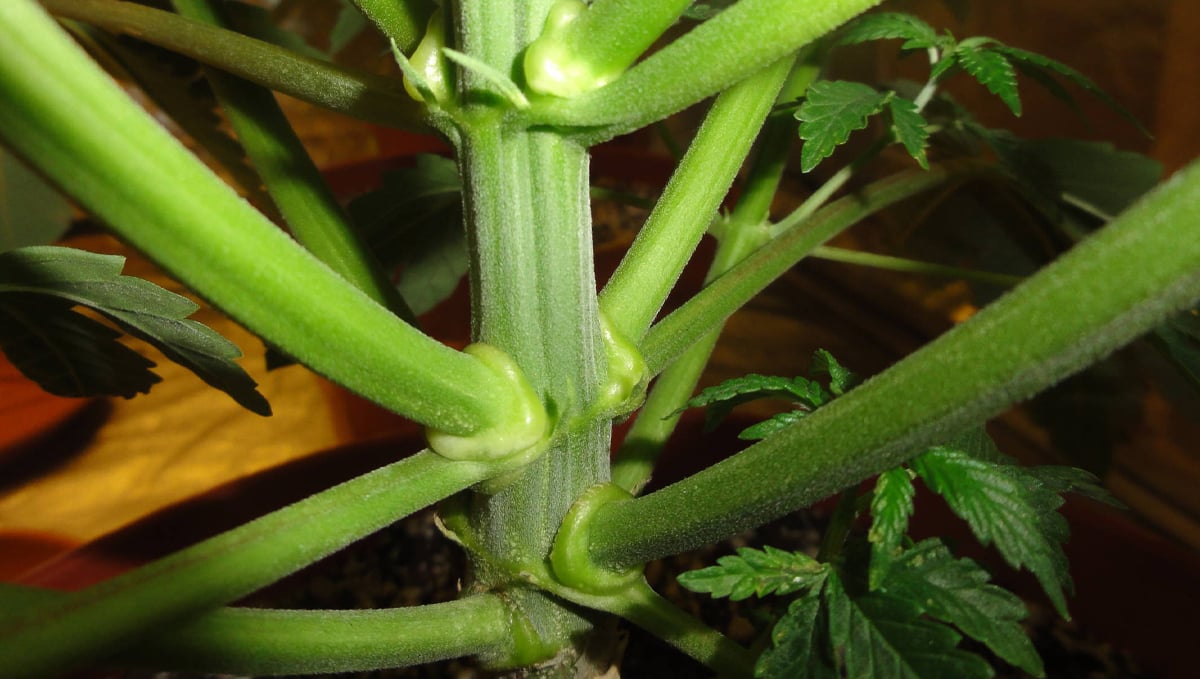
Nodes, branches and the stem of a cannabis plant.
The main part of a cannabis plant’s anatomy is the stem, the stem provides support to the foliage, branches, and flowers (basically the whole plant), inside the stem, there is a vascular system that consists of the Xylem and Phloem.
The Xylem transports water and the nutrients dissolved in water while the Phloem is responsible for transporting sugars, proteins, and other organic molecules in plants.
Sometimes plants can develop mutations, these mutations are genetic mutations so they cannot be fixed, and although some mutations can result in odd growth such as irregular branching and leaf growth, they can still produce good quality flowers, despite sometimes the yields being affected.
8. NODES
Nodes are the point where branches come off from the stem, in the vegetative stage of a cannabis plant they’re parallel to each other but when your plant begins flowering the appearance of nodes can become irregular, now this isn’t a problem at all, it’s just a characteristic of some cannabis strain and is usually a trait that can help you identify a certain plant’s species.
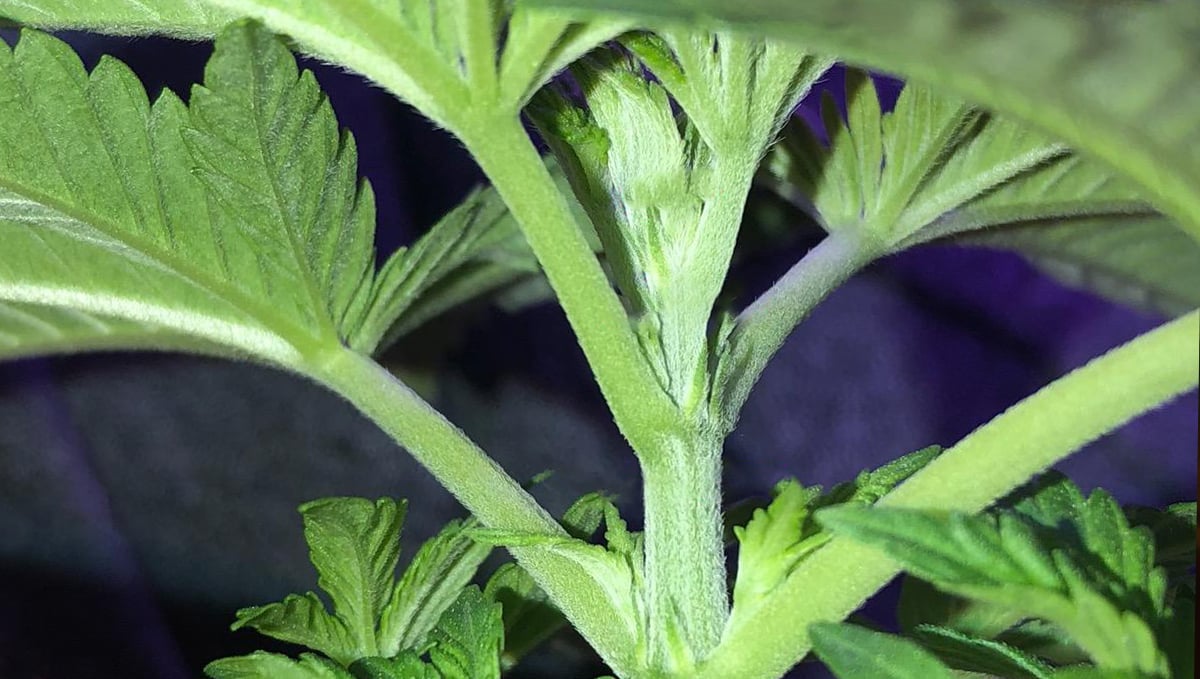
The nodes of a cannabis plant.
Have in mind that nowadays most cannabis strains are hybrids (a combination of Indica and Sativa genetics) so this won’t always be 100% correct but usually, Indicas tend to have nodes that are closer together while Sativa’s nodes are usually more spaced out.
These nodes are essential because they are where the buds or pollen sacs will start to develop and it’s where the first signs of your plant’s sex appear.
9. FLOWERS (BUDS)
The buds (flowers) are the most important part for growers but also for the cannabis plant, the flowers play several roles such as attracting pollinators and producing seed (once they’re fertilized) to perpetuate the species.
Nowadays you can find feminized seeds which means the seeds will result in 100% female plants but in nature, cannabis plants are dioecious which means the plants will be male or female, as said before.
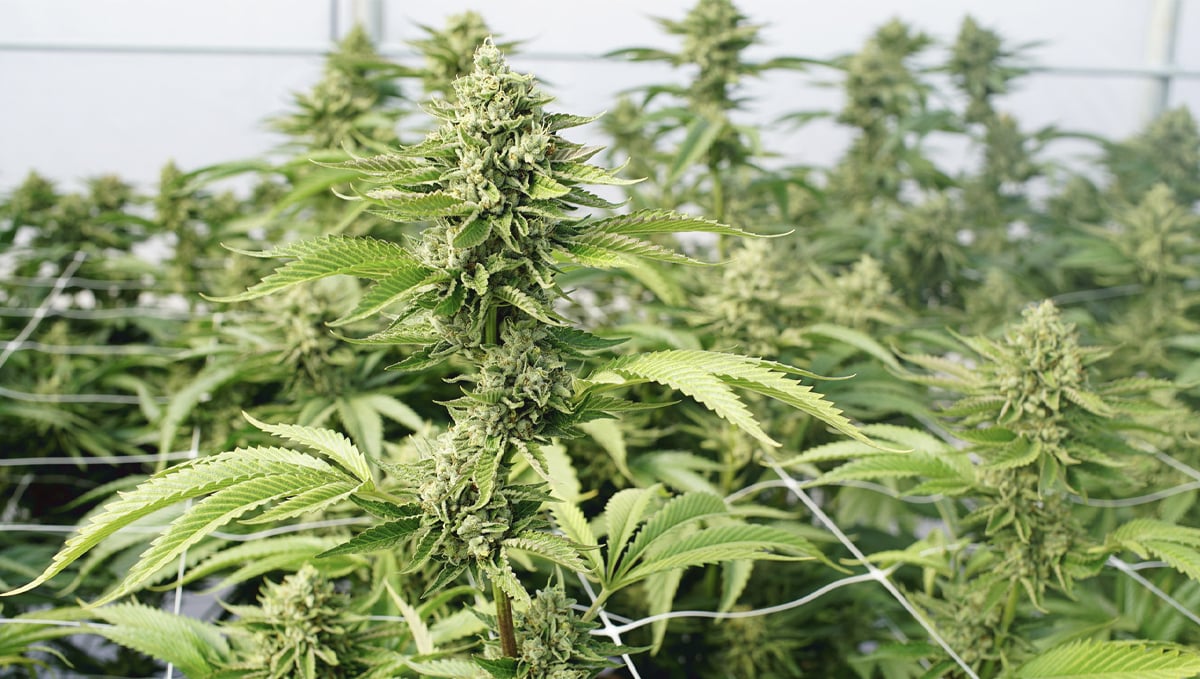
Main cola of a cannabis plant in full-flowering mode.
The pre-flowering stage is vital in differentiating whether the plant is a male or a female because it’s when a plant will show the first signs of its sex.
The flowers that form on the top of the stem are known as the cola, typically, a plant has one main cola but growers have come up with several methods of creating multiple main colas with plant training techniques (such as LST and HST) that help increase yields.
The main cola is known as the apical bud or main cola and it’s where most of the buds gather together to form the main bud, you’ll also see small clusters of flowers between the foliage in the internodes but, compared to the main cola, the side colas are smaller so this is why growers use both LST and HST.
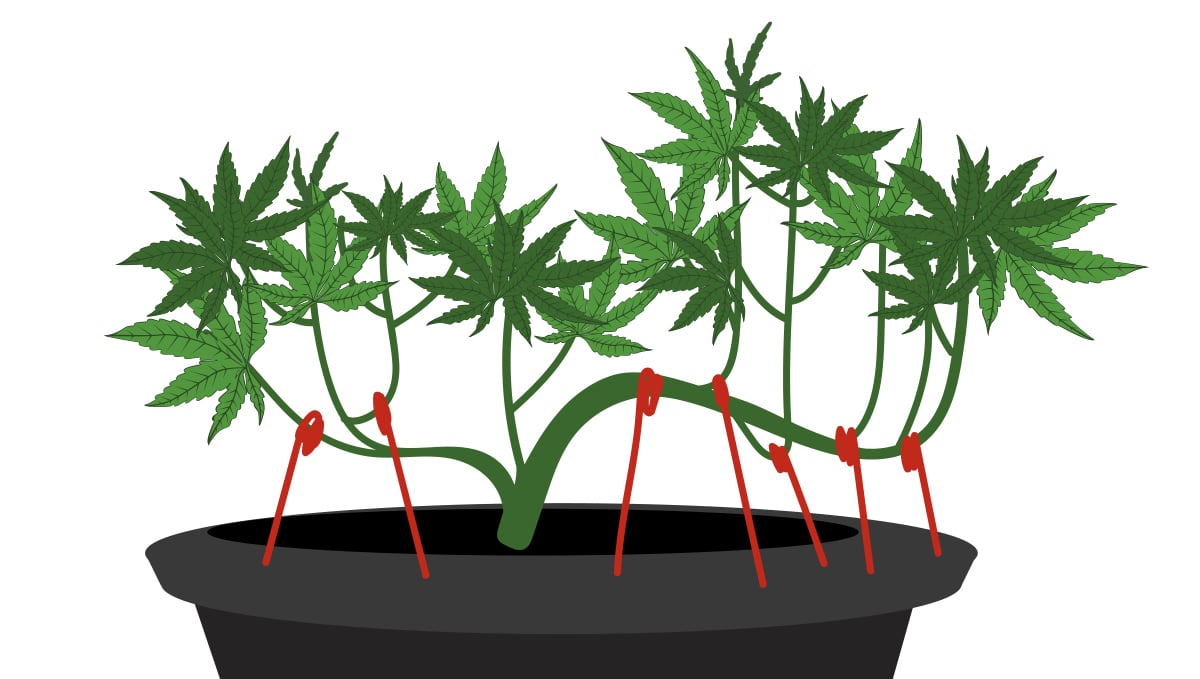
Tying down the branches is a LST technique.
These two plant training methods end up changing the structure of the plant by exposing the flowering sites to more light and airflow, allowing the buds to grow bigger while also improving their quality.
When talking about flowers, there’s a distinction between female and male flowers. Male plants usually develop 2-3 weeks earlier than female flowers and, as said above, do not develop buds but they also form colas that consist of pollen sac clusters.
10. PISTILS AND STIGMAS
The pistils and stigmas are the reproductive parts of the female flowers, most cannabis consumers know the stigmas as pistils but that is wrong because the pistils are the part where the stigmas (white hairs) grow from.
These hair-like parts are responsible for collecting pollen grains from the male flowers and consequently, produce seeds.
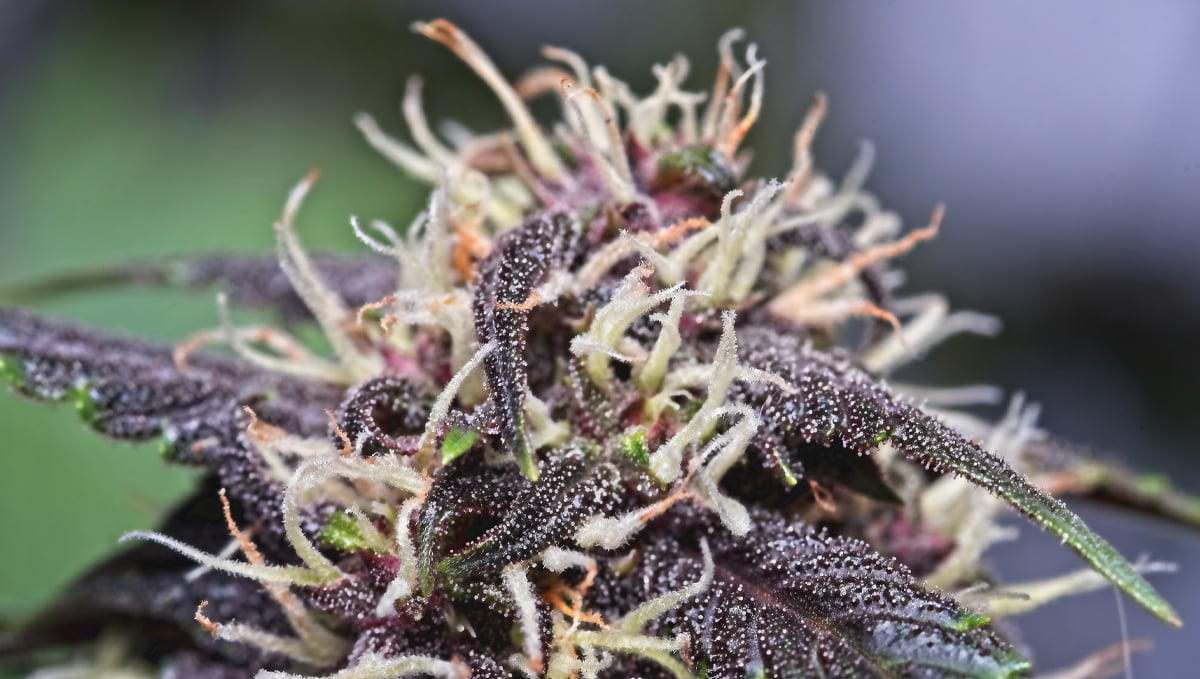
Pistils and stigmas on a beautiful purple bud.
When a cannabis plant is fully mature, the stigmas can change color several times, usually starting with white hues, then yellow, orange, or red, and lastly, brown.
Now, have in mind that the stigmas do not affect the potency or taste because they do not store any cannabinoids and don’t have trichomes so they won’t influence the quality and effect of your buds.
11. BRACTS
The bracts, which are usually called calyxes by mistake, are what actually form the buds on a cannabis plant, they are pear-shaped nodules that develop between the sugar leaves but depending on the strain, they can appear in several colors, shapes, and sizes.

The anatomy of cannabis bracts.
When the stigmas get pollinated, the bracts essentially turn into an ovary (seed incubator) which allows the seeds to grow and ripen but ends up affecting the yields and can affect the resin quantity on your buds, that’s why “sinsemilla” or feminized seeds are preferred by growers and consumers.
A non-pollinated flower is usually trichome-rich because your harvest will have more trichomes and they are responsible for producing and storing terpenes and cannabinoids.
12. TRICHOMES
Trichomes are the tiny crystals found all over the buds and surrounding foliage and are considered the most important part for cannabis consumers, these mushroom-shaped glands are clear and sticky, and form a thick layer on the buds.
These mushroom-shaped glands known as trichomes can be found in different types and sizes, they are:
- Capitate-stalked trichomes 100 µm;
- Cystholitic trichomes 50 µm.
- Unicellular non-glandular trichomes 20 µm;
- Capitate sessile trichomes 20 µm;
- Complex bulbous trichomes 10 µm and;
- Simple bulbous trichomes 10 µm;
All “recreational strains” are THC-rich, depending on the strain, the trichome production may differ, resulting in more or fewer trichomes on your plants, but either way, all cannabis plants will produce trichomes.

The different types of trichomes found on cannabis plants.
For home growers, the trichomes are the standard practice to know exactly when to harvest but in nature, the compounds produce by the cannabis plant provide defense mechanisms, such as terpenes, which smell helps keep away predators.
Also, the sticky trichomes protect the buds from insects and against UV light, and although we don’t usually think about this when growing indoors, all the parts of a cannabis plant have an important role when cannabis plants grow in nature.
13. THE LIFE CYCLE OF CANNABIS PLANTS
Now that you know everything you need about the anatomy of cannabis plants, let’s understand a bit more about the life cycle of cannabis plants. Cannabis plants can take anywhere from 8 to 32 weeks to grow and mature, and during this time it goes through four stages, they are:
- Germination stage;
- Seedling stage;
- Vegetative stage;
- Flowering stage.
And it’s essential for you to understand these stages to grow healthy plants as each stage requires different light spectrums, light cycles, nutrients, and growing conditions.
THE GERMINATION STAGE
Just like with any other plant, cannabis plants start from seeds. Cannabis seeds are dormant until exposed to warmth and moisture. This means that if you are looking to germinate cannabis seeds or any other type of seed, you will have to hydrate it and place it in good conditions.
After planted, seeds can take anywhere from 3 to 10 days to germinate and seeds contain enough food for 2-3 weeks, which means there's no need to water with a nutrient solution until the seedling has come out of the soil. Once the seedling comes out of the soil, you’ll see two small rounded leaves which are called cotyledons, and this is what marks the beginning of the seedling stage.
THE SEEDLING STAGE
The seedling stage of cannabis plants can take anywhere from 1- 3 weeks, and sometimes more depending on the strain and growing conditions. During the seedling stage, plants focus on developing roots and foliage, this means that the roots are still small and fragile so be careful to not overfeed or overwater them. Once you’re in the seedling stage, make sure to provide 18 hours of light and 6 hours of darkness, and remember to keep an eye on them as they’re extremely susceptible to pests and diseases.
THE VEGETATIVE STAGE
After a couple of weeks in the vegetative stage, your plants will start needing more food, light, and water as the roots and foliage start to grow exponentially. During the vegetative stage, you have to make sure you’re feeding your plant higher levels of nitrogen and less phosphorus and potassium as nitrogen is needed to develop foliage. If you’re growing indoors, the general rule is to flip to 12/12 (which triggers flowering) once the plant is ⅓ or ½ of the size you want them to be by harvest.
THE FLOWERING STAGE
Once you flip to 12/12 (or when autumn comes outdoors), your plants will start flowering. The flowering stage can take anywhere from 6 to 10 weeks or even more, depending on the strain. This stage starts with the appearance of pre-flowers which will eventually fatten up and turn into those delicious sticky flowers you've been waiting for so long. Obviously, this is just a quick rundown and there are a lot of things to keep in mind, other than the light cycle but understanding the life cycle and anatomy of cannabis plants will allow you to anticipate problems before they happen.
14. IN CONCLUSION
Cannabis plants are millennial plants that have developed and perfected their structure throughout the years, even though we don’t see it like that, all the parts of a cannabis plant are essential for them to grow and perpetuate their species.
Feel free to leave tips and more important information to help educate fellow growers, leave a comment in the comment section below!
© 2025 Benzinga.com. Benzinga does not provide investment advice. All rights reserved.
Trade confidently with insights and alerts from analyst ratings, free reports and breaking news that affects the stocks you care about.
Cannabis is evolving – don’t get left behind!
Curious about what’s next for the industry and how to leverage California’s unique market?
Join top executives, policymakers, and investors at the Benzinga Cannabis Market Spotlight in Anaheim, CA, at the House of Blues on November 12. Dive deep into the latest strategies, investment trends, and brand insights that are shaping the future of cannabis!
Get your tickets now to secure your spot and avoid last-minute price hikes.